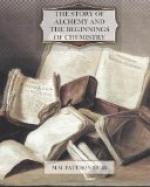If the essence were ever attained, it would be by following the course which nature follows in producing the perfect plant from the imperfect seed, by discovering and separating the seed of metals, and bringing that seed under the conditions which alone are suitable for its growth. Metals must have seed, the alchemists said, for it would be absurd to suppose they have none. “What prerogative have vegetables above metals,” exclaims one of them, “that God should give seed to the one and withhold it from the other? Are not metals as much in His sight as trees?”
As metals, then, possess seed, it is evident how this seed is to be made active; the seed of a plant is quickened by descending into the earth, therefore the seed of metals must be destroyed before it becomes life-producing. “The processes of our art must begin with dissolution of gold; they must terminate in a restoration of the essential quality of gold.” “Gold does not easily give up its nature, and will fight for its life; but our agent is strong enough to overcome and kill it, and then it also has power to restore it to life, and to change the lifeless remains into a new and pure body.”
The application of the doctrine of the existence of seed in metals led to the performance of many experiments, and, hence, to the accumulation of a considerable body of facts established by experimental inquiries. The belief of the alchemists that all natural events are connected by a hidden thread, that everything has an influence on other things, that “what is above is as what is below,” constrained them to place stress on the supposed connexion between the planets and the metals, and to further their metallic transformations by performing them at times when certain planets were in conjunction. The seven principal planets and the seven principal metals were called by the same names: Sol (gold), Luna (silver), Saturn (lead), Jupiter (tin), Mars (iron), Venus (copper), and Mercury (mercury). The author of The New Chemical Light taught that one metal could be propagated from another only in the order of superiority of the planets. He placed the seven planets in the following descending order: Saturn, Jupiter, Mars, Sol, Venus, Mercury, Luna. “The virtues of the planets descend,” he said, “but do not ascend”; it is easy to change Mars (iron) into Venus (copper), for instance, but Venus cannot be transformed into Mars.
Although the alchemists regarded everything as influencing, and influenced by, other things, they were persuaded that the greatest effects are produced on a substance by substances of like nature with itself. Hence, most of them taught that the seed of metals will be obtained by operations with metals, not by the action on metals of things of animal or vegetable origin. Each class of substances, they said, has a life, or spirit (an essential character, we might say) of its own. “The life of sulphur,” Paracelsus




